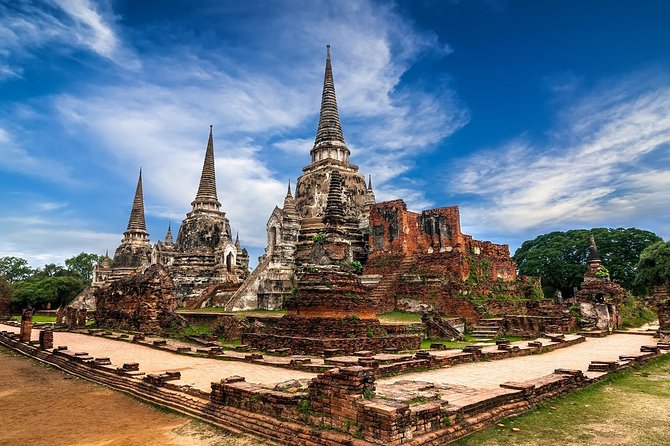Have you ever wondered what it would be like to step back in time and explore ancient temples? Well, if you’re a history enthusiast like me, then the ancient temples of Ayutthaya should definitely be on your travel bucket list. In this article, we’ll take a closer look at Ayutthaya and its magnificent temples, and I promise you’ll be amazed by the rich history and breathtaking beauty that awaits you in this historical city.
Ayutthaya, located just a short distance north of Bangkok, was once the thriving capital of the Kingdom of Siam. From the 14th to the 18th century, this city was a bustling center of trade and culture, and its temples were a testament to the wealth and power of the Siamese rulers. Today, Ayutthaya is a UNESCO World Heritage Site, and it offers visitors a chance to explore the remnants of its glorious past.
As you wander through the ancient temples of Ayutthaya, you’ll be transported to a bygone era. The architecture of these temples is truly awe-inspiring, with intricate carvings, towering pagodas, and ornate statues that showcase the exquisite craftsmanship of the Siamese artisans. Each temple tells a unique story, and you’ll have the opportunity to immerse yourself in the history and legends surrounding these sacred sites.
So, if you’re ready to embark on a historical journey like no other, join me in exploring the ancient temples of Ayutthaya. In the upcoming article, we’ll delve deeper into the must-visit temples, share tips for navigating the city, and provide insights into the best times to visit. Get ready for an adventure of a lifetime in this enchanting land of ancient wonders.
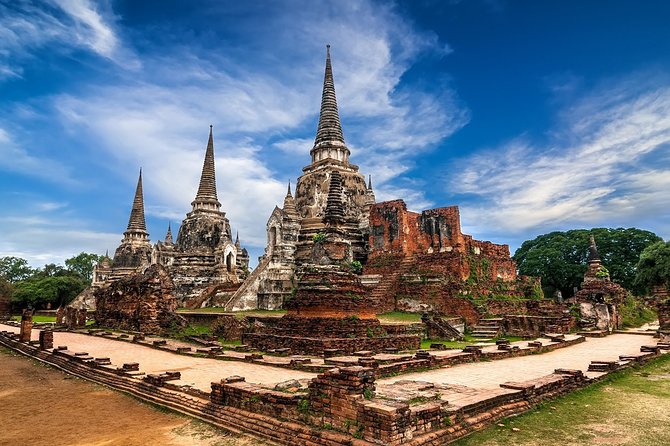
Ayutthaya: The Ancient City
Ayutthaya, the ancient capital of the Kingdom of Siam, is a city steeped in history, culture, and architectural marvels. Located just a short distance from Bangkok, it served as the capital of Thailand for over four centuries, from 1350 to 1767. Ayutthaya was a thriving cosmopolitan city and a center of political, economic, and cultural power in Southeast Asia.
The Rise and Fall of Ayutthaya Kingdom
The Ayutthaya Kingdom was founded by King Ramathibodi I in 1350, marking the beginning of an era of prosperity and growth. The kingdom flourished under the reigns of subsequent monarchs, expanding its territories, establishing trade relations with neighboring countries, and becoming a major regional power. The city of Ayutthaya was strategically located on an island surrounded by three rivers, which provided natural defense and facilitated trade.
However, the golden age of Ayutthaya came to an abrupt end in 1767 when the city was invaded and destroyed by the Burmese army. The once magnificent palaces, temples, and monuments were reduced to ruins, leaving behind a haunting reminder of the city’s glorious past.
Location and Historical Significance
Situated in the heart of Thailand, Ayutthaya is of great historical significance. Its location at the confluence of the Chao Phraya, Lopburi, and Pa Sak rivers made it an important trading hub, connecting mainland Southeast Asia with the rest of the world. The city’s strategic position allowed it to flourish both economically and culturally, attracting merchants, scholars, and artisans from various parts of the world.
Architectural Marvels of Ayutthaya
Ayutthaya is renowned for its impressive temples and monuments that showcase the architectural prowess of the ancient Siamese civilization. Despite the ravages of time and the destruction caused by the Burmese invasion, many temples still stand today, serving as a testament to the city’s rich architectural heritage.
Wat Phra Si Sanphet: A Symbol of Power
History and Background of Wat Phra Si Sanphet
One of the most significant temples in Ayutthaya is Wat Phra Si Sanphet. It was originally built as a royal temple within the grounds of the Grand Palace, serving as the royal monastery and housing the ashes of Ayutthaya’s kings. The temple was a symbol of the city’s political power and was known for its grandeur and opulence.
Features and Design of the Temple
Wat Phra Si Sanphet boasted a magnificent collection of pagodas, chedis, and other religious structures. The central pagoda, known as a prang, stood at an impressive height and was adorned with intricate carvings and colorful ceramics. The temple complex was surrounded by a wall and had three main stupas, each housing relics and ashes of different kings.
Religious Significance and Cultural Practices
Wat Phra Si Sanphet was not only a symbol of power but also a spiritual center. It played a significant role in religious ceremonies and was a place of worship for the people of Ayutthaya. Buddhists would pay their respects, make offerings, and seek blessings from the monks. The temple also served as a venue for important royal ceremonies and processions.
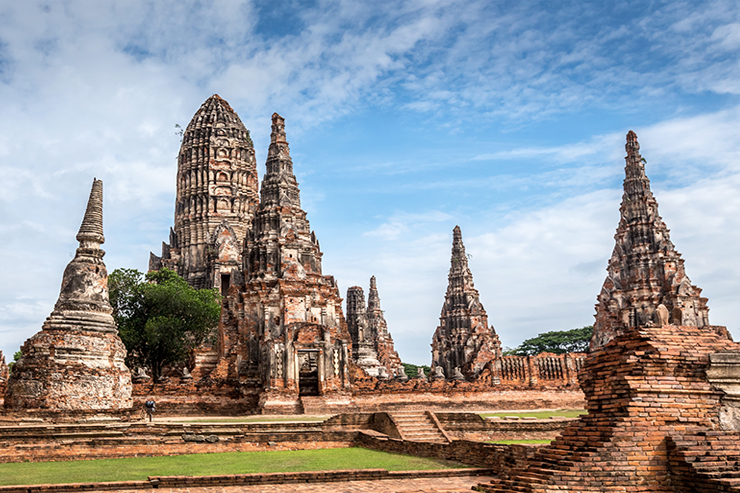
Wat Phra Mahathat: The Enigmatic Ruins
Origins and Tales of Wat Phra Mahathat
Wat Phra Mahathat is another iconic temple in Ayutthaya, known for its enigmatic ruins and the famous Buddha head engulfed in tree roots. Legend has it that the temple was built to enshrine a relic of the Buddha, which was brought from India. The temple was a center of learning, attracting scholars and monks from far and wide.
The Famous Buddha Head Engulfed in Tree Roots
Perhaps the most captivating aspect of Wat Phra Mahathat is the Buddha head entwined in the roots of a Bodhi tree. This sight has become an emblem of Ayutthaya itself, representing the harmony between nature and spirituality. The image is said to have been placed there naturally over time, as the roots grew around it, creating a mystical and awe-inspiring scene.
Exploring the Buddhist Scriptures and Statues
Apart from its famous Buddha head, Wat Phra Mahathat also houses a vast collection of Buddhist scriptures and statues. The temple was a renowned center for Buddhist studies, attracting scholars and monks who dedicated their lives to the study and preservation of Buddhist teachings. Exploring the temple grounds, one can witness the remnants of intricate statues and sculptures that once adorned the temple complex.
Wat Ratchaburana: A Glimpse into the Past
Historical Background of Wat Ratchaburana
Wat Ratchaburana holds a significant place in Ayutthaya’s history, as it was built to honor two royal brothers who died fighting for the throne. The temple was established by the victorious brother to commemorate his fallen siblings and was adorned with intricate architecture and beautiful murals.
The Intricate Architecture and Murals
The architecture of Wat Ratchaburana is a blend of Khmer and Ayutthaya styles, exemplifying the cultural fusion that occurred during the kingdom’s reign. The temple’s central prang towers above the surrounding structures, with elaborate carvings and decorative elements adorning its exterior. Inside, the walls are adorned with stunning murals depicting scenes from Buddhist scriptures and Ayutthaya’s history.
The Mysterious Burial Chamber
What sets Wat Ratchaburana apart from other temples is its underground crypt, which was discovered in the 1950s. The crypt contained a collection of gold artifacts and precious relics, indicating that it was used as a burial chamber for the royal family. Exploring this ancient burial site gives visitors a glimpse into the funerary practices and customs of the Ayutthaya period.
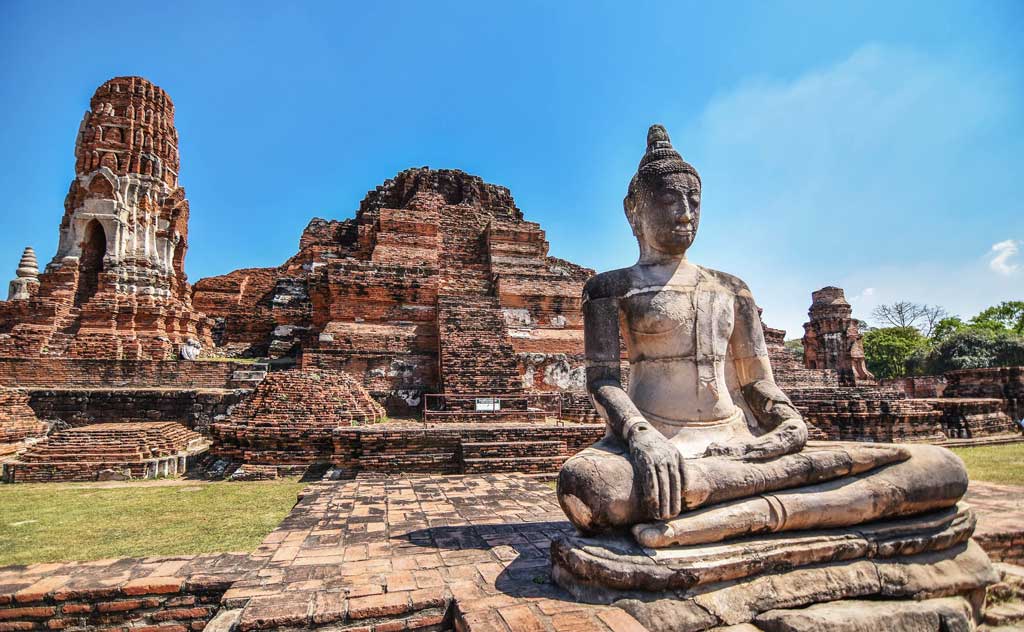
Wat Chaiwatthanaram: Majestic Riverside Temple
Creation and Purpose of Wat Chaiwatthanaram
Wat Chaiwatthanaram, located on the banks of the Chao Phraya River, was built by King Prasat Thong as a symbol of his power and merit-making. The temple was constructed in Khmer-style architecture, reflecting the influence of the neighboring Khmer Empire on Ayutthaya’s culture and art.
Splendid Khmer-Style Architecture
The beauty of Wat Chaiwatthanaram lies in its grand architecture and intricate details. The central prang, surrounded by smaller towers and galleries, creates a mesmerizing sight. The temple’s galleries feature stunning bas-reliefs depicting scenes from the Ramayana, showcasing the artistic skills of the Ayutthaya period.
Rituals and Festivals at the Temple
Wat Chaiwatthanaram continues to be an active temple, attracting both locals and tourists alike. The temple serves as a place of worship and is frequented by devotees who come to make merit, offer prayers, and participate in religious rituals. During festivals such as Songkran, Loy Krathong, and Visakha Puja, the temple comes alive with colorful decorations, processions, and ceremonial activities.
Wat Yai Chai Mongkol: A Place of Triumph
The Story of Ayutthaya’s Victory
Wat Yai Chai Mongkol was erected to commemorate King Naresuan the Great’s victory over a Burmese crown prince in a legendary elephant duel. The temple stands as a reminder of Ayutthaya’s military triumphs and the resilience of its people.
The Glorious Chedi and Pagodas
The centerpiece of Wat Yai Chai Mongkol is its towering chedi, which is visible from afar. The chedi, adorned with ornate details and surrounded by smaller pagodas, commands attention and evokes a sense of awe. Climbing to the top of the chedi rewards visitors with panoramic views of Ayutthaya’s historical site and the surrounding countryside.
Monks and Meditation Practices
While Wat Yai Chai Mongkol attracts tourists with its grandeur and historical significance, it remains an active monastery where monks reside and practice meditation. Visitors can witness the monks performing their daily routines and rituals, offering a glimpse into the tranquil and disciplined life of a Buddhist monk.
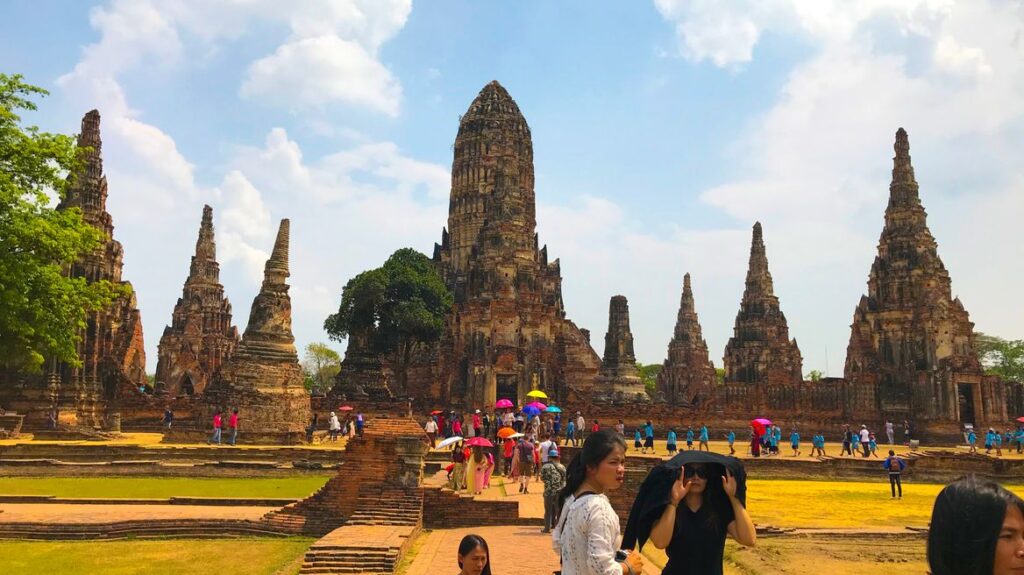
Wat Lokayasutharam: The Reclining Buddha
Meaning and History of Wat Lokayasutharam
Wat Lokayasutharam is home to the largest reclining Buddha image in Ayutthaya. The temple’s name translates to “Temple of the Earth’s Ascetics” and is believed to have been constructed during the 14th century. The reclining Buddha image represents the final moments of the Buddha’s life before attaining enlightenment.
The Largest Reclining Buddha Image in Ayutthaya
The reclining Buddha at Wat Lokayasutharam measures an impressive 37 meters in length and is covered in a layer of gold paint. The serene expression on the Buddha’s face and the sheer size of the statue create a sense of peace and tranquility. Visitors can pay their respects and offer prayers in front of the statue, immersing themselves in the spiritual ambiance of the temple.
Cultural Practices and Offerings
Wat Lokayasutharam is a place of worship and meditation for Buddhists. Visitors will often find locals lighting incense sticks, making merit, and offering flowers or food to the Buddha. The temple also hosts various celebrations and religious events throughout the year, allowing visitors to experience the vibrant culture and spiritual practices of Ayutthaya.
Wat Na Phra Meru: The Royal Monastery
Royal Connections and Historical Significance
Wat Na Phra Meru, also known as the Royal Monastery, holds immense historical significance as it was once used by Ayutthaya’s royals for meditation and religious ceremonies. The temple was built in the early 17th century and remained a sacred site for the royal family.
The Grand Ordination Hall and Bell-shaped Chedi
The main attraction of Wat Na Phra Meru is the Grand Ordination Hall, a magnificent structure decorated with intricate wood carvings and gilded details. The hall served as a venue for ordination ceremonies, where young men would enter the monkhood. Another notable feature is the bell-shaped chedi that stands tall in the temple complex, adding to the majestic beauty of the site.
Monastic Traditions and Monks’ Way of Life
While Wat Na Phra Meru is no longer a royal monastery, it still remains an important place of worship and learning. The temple complex houses living quarters for monks, meditation halls, and libraries. Observing the monks’ way of life, with their daily routines of prayer, study, and alms collection, offers a glimpse into the monastic traditions and the Buddhist path of compassion and mindfulness.
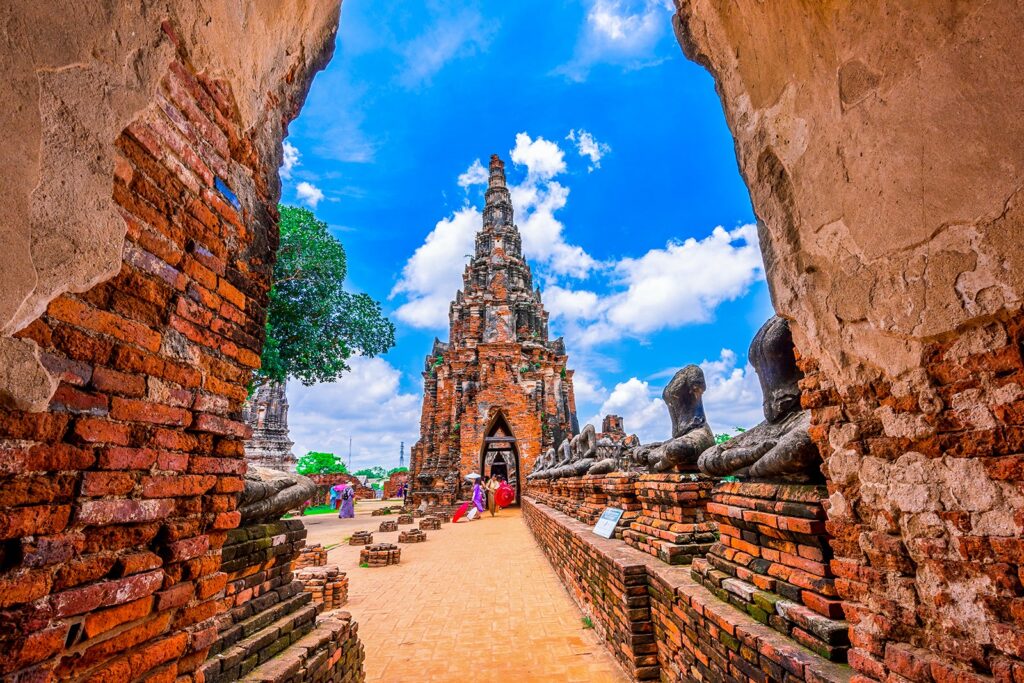
Wat Phu Khao Thong: The Golden Mountain Temple
The Legend of King Naresuan
Wat Phu Khao Thong, also known as the Golden Mountain Temple, is situated on a hill overlooking the city of Ayutthaya. The temple is associated with the legendary King Naresuan and his victorious return to Ayutthaya after defeating the Burmese army. The temple was built to commemorate his triumph and honor his reign.
The Towering Golden Chedi
The most striking feature of Wat Phu Khao Thong is its towering golden chedi, which can be seen from miles away. The chedi shines brightly against the sky, creating a magnificent spectacle. The chedi’s intricate design and golden exterior represent the grandeur and opulence of the Ayutthaya Kingdom.
Panoramic Views and Serene Atmosphere
Climbing to the top of the hill where Wat Phu Khao Thong is situated offers visitors breathtaking panoramic views of Ayutthaya’s ruins and the surrounding landscape. The serene atmosphere atop the hill provides a peaceful escape from the bustling city below, allowing visitors to reflect on the historical significance of Ayutthaya and appreciate the beauty of the temple.
Conclusion
Exploring the ancient temples of Ayutthaya is like taking a journey back in time. The rich history, cultural significance, and architectural grandeur of these temples make them a must-visit for anyone interested in Thailand’s past. As you wander through the ruins and marvel at the intricate designs, you can’t help but feel a sense of reverence for the city’s former glory.
Preservation efforts have been made to safeguard these temples and protect them from further deterioration. The Thai government, along with UNESCO, has recognized the historical and cultural value of Ayutthaya, leading to its classification as a World Heritage Site. The influx of tourists, both local and international, has also contributed to the preservation of these temples by generating funds for maintenance and restoration projects.
Visiting Ayutthaya’s temples is not only a journey through history but also a spiritual experience. The temples serve as a reminder of the importance of Buddhism in Thai culture and the values it promotes—compassion, mindfulness, and inner peace. Exploring these ancient sites allows you to connect with the spiritual essence of the city and gain a deeper appreciation for its historical legacy.
So, if you find yourself in the vibrant city of Bangkok, take a day trip to Ayutthaya and embark on a historical journey through the ancient temples. Immerse yourself in the beauty and tranquility of these sacred sites, and let the stories of the past captivate your imagination. Ayutthaya awaits, ready to transport you to a bygone era of grandeur and spiritual enlightenment.
